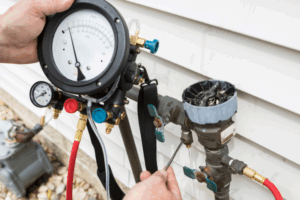Ever wondered how to test the backflow preventer on sprinkler system components properly? Knowing how to test backflow preventers on sprinkler system setups is essential for keeping your water supply safe and contamination-free.
A backflow preventer plays a critical role in stopping dirty water from reversing into your clean water supply. Over time, it can fail without warning, and that can lead to serious health risks. But don’t worry. With a few simple steps and the right approach, you can test your backflow preventer like a pro and protect your home and family.
In this guide, we’ll walk you through the steps to inspect and test your sprinkler system’s backflow preventer, identify potential problems, and maintain your system with confidence.
Why Testing Your Backflow Preventer Matters

A backflow preventer is designed to keep irrigation water, often full of fertilizers, dirt, and other debris, from flowing backward into your home’s drinking water. If it fails, those contaminants could find their way into your kitchen faucet. Testing ensures your device is functioning properly and meets local regulations.
Tools You’ll Need Before You Start
Before diving into the testing process, gather these tools:
- Backflow test kit (available at hardware or irrigation stores)
- Screwdrivers and adjustable wrenches
- Pressure gauge (often included in test kits)
- Safety gloves and glasses
- A pen and a notepad for documentation
Step-by-Step Guide: How to Test Backflow Preventer on Sprinkler System
Follow these simplified steps to perform the test:
Turn Off Your Water Supply
Shut off the main water valve going to the sprinkler system. This prevents pressure buildup while you work.
Locate the Backflow Preventer
It’s usually positioned above ground near the sprinkler valves. The most common types are double-check valves or pressure vacuum breakers (PVBs).
Connect Your Test Kit
Attach the test gauge to the test cocks (valve ports) on the preventer. Follow the manufacturer’s guide for the correct sequence.
Check for Leaks and Pressure Loss
Open each test cock slowly and read the pressure. Watch for sudden drops in pressure, leaks, or reverse water flow—all signs of a faulty preventer.
Document Results
Record your findings. If anything appears off or outside the safe range, it may be time to repair or replace the device.
Signs Your Backflow Preventer May Need Repair
- Dripping water or visible leaks near the unit
- Strange water taste or discoloration
- Decreased water pressure in your home
- Failure during a pressure test
When to Call a Professional
If you’re unsure about your test results or don’t have the right equipment, it’s smart to hire a licensed backflow tester. Some states even require certified professionals to conduct official annual tests.
Understanding the Types of Backflow Preventers
Before you begin testing, it’s important to know what type of backflow preventer your sprinkler system uses. The testing method may vary slightly depending on the design.
Here are the most common types:
Pressure Vacuum Breaker (PVB):
This is the most common type used in residential sprinkler systems. It prevents back-siphonage and is installed above ground, usually with a single valve and air inlet.
Double Check Valve Assembly (DCVA):
Often used in both residential and commercial systems, this has two check valves for added protection. It’s usually installed below ground in a valve box.
Reduced Pressure Zone (RPZ) Assembly:
This is the most reliable and also the most complex. It features two valves and a pressure relief valve between them. RPZs are required in higher-risk systems and typically need professional testing.
Identifying your backflow preventer will help ensure you follow the right steps and avoid damaging any components during testing.
Local Regulations and Compliance
Did you know that many cities and counties require annual backflow testing by certified professionals?
Local plumbing codes often mandate that property owners test their backflow preventers each year, especially if the system connects to a public water supply. Some areas may also require you to submit test results to your water provider.
What to do:
- Check with your local water authority or municipal website for specific rules in your area.
- Ask whether self-testing is allowed or if a licensed tester is required.
- Keep records of all backflow preventer inspections and repairs.
By staying compliant, you’re not just protecting your home; you’re also avoiding potential fines and helping maintain the safety of your community’s water supply.
Preventive Maintenance Tips for Backflow Preventers
Routine maintenance can extend the life of your backflow preventer and help you avoid surprise repairs or failed inspections. Here are a few quick tips:
Inspect seasonally:
Look for signs of corrosion, leaks, or insect nests, especially after winter or before irrigation season begins.
Exercise the valves:
Open and close the shut-off valves a few times throughout the season to keep them from getting stuck.
Protect from freezing:
In colder climates, cover your backflow preventer with insulation or a weather-resistant enclosure to prevent cracking in winter. You can also winterize your sprinkler system and hoses by draining the lines manually, using automatic flush valves, or blowing out the system with compressed air to avoid freeze-related damage
Keep the area clear:
Avoid piling soil, mulch, or plants too close to the device. It should remain visible and accessible at all times.
Flush the system occasionally:
Sediment buildup can affect performance, so flushing your sprinkler lines periodically can help.
With just a few minutes of attention each season, you can keep your backflow preventer functioning reliably and reduce the chance of contamination or costly fixes.
Conclusion
Keeping your sprinkler system’s backflow preventer in good working condition is essential for protecting your home’s water supply and meeting Cleveland’s local testing requirements.
Knowing how to test backflow preventers on sprinkler system setups can help you catch problems early and avoid costly repairs or contamination. But if you’re unsure how to proceed or need help with the annual test, it’s always best to contact a licensed backflow tester in Cleveland to ensure your system stays safe, compliant, and ready for the watering season.
